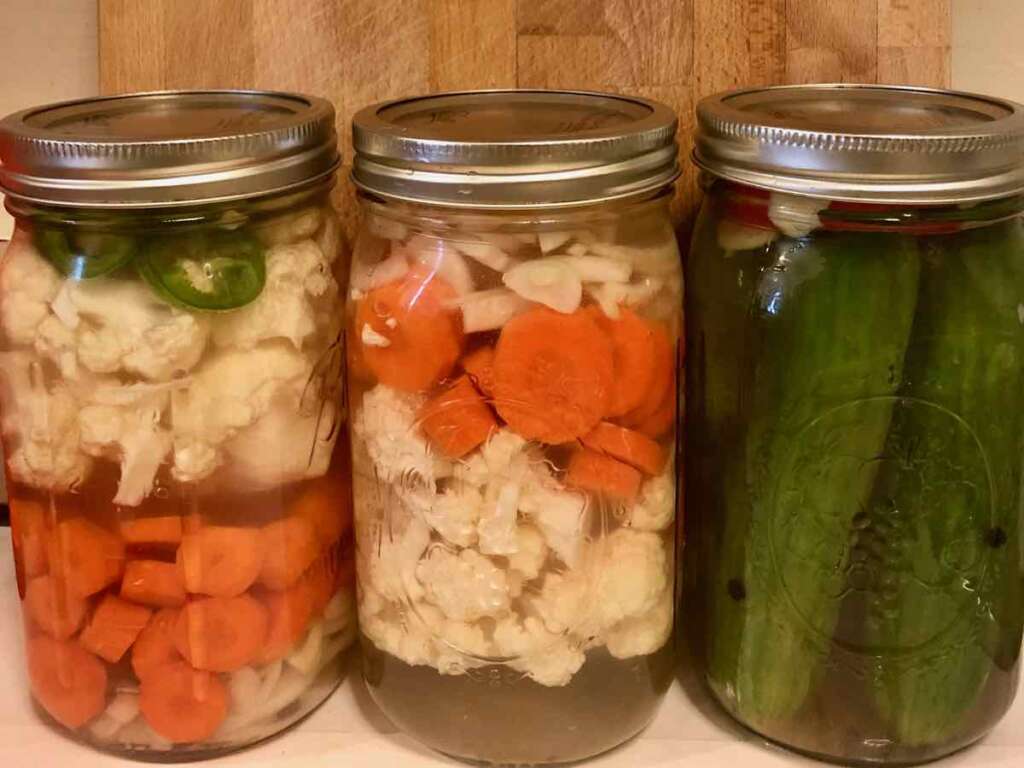Ferments and The Health Benefits of Fermentation

Many traditional cultures preserved food through fermentation. In addition to preservation, culturing foods introduces live probiotics, beneficial microbes, into the gut and encourages a healthy microbiome.
Incorporating fermented foods into the diet, may be an easy way to support your health and add a lovely flavor profile to your meals! Here are some of the many health benefits to consuming fermented foods.
The Health Benefits of Fermented Foods
Rather than trying to cover all fermented foods, here are a few examples of easily accessible fermented products and their benefits!
Lacto-Fermented Vegetables
Preserving vegetables without freezing or canning, was traditionally done through a process of lacto-fermentation. The sugars and starches in vegetables are converted to lactic acid by the lactobacilli bacteria1.
In turn, the lactic acid inhibits bacteria which would cause the vegetable to rot. Some examples of lacto-fermented vegetables include sauerkraut, pickles, olives, kimchi, and various relishes.
Lactobacilli are normal inhabitants of the human gut and mucus membranes throughout the body.
In addition to maintaining an acidic environment, through the production of lactic acid, they produce substances such as hydrogen peroxide, an anti-septic, and other anti fungal and anti bacterial agents. Furthermore, they stimulate the immune system and aid in cell renewal in the gut2.
Cultured Dairy Products
Lactobacilli are not the only probiotics, but they are some of the most common and easily cultured at home. Another example of lacto-fermentation is in cultured dairy products, such as yogurt and kefir.
During the culturing process, lactic acid producing bacteria break down the milk sugar (lactose) and protein (casein). This makes fermented dairy products easier to digest.
Consuming cultured dairy products has also been shown to provide beneficial bacteria (probiotics) to the digestive tract. These bacteria not only help complete digestion of our food, but also guard against pathogens in the digestive tract.
Additionally, culturing your dairy products will restore many enzymes that are destroyed by modern pasteurization methods, including lactase, which helps digest milk sugar. Vitamin B and vitamin C are also increased during milk fermentation1!
What is the difference between Ferments and Cultured Foods?
Both ferments and cultured food contain probiotics. The difference is in the method of preparation. A ferment, also called a wild ferment, will employ a method such as lacto-fermentation mentioned above. This means using the bacteria naturally found in the food.
A cultured food, is one where a designated “culture” or specific strains of bacteria and/or yeast are added to the product to culture it.
For example, when you make yogurt, you are adding the lactobacillus bulgaricus bacteria to milk. Another example would be adding a SCOBY (symbiotic culture of bacteria and yeast) to tea, to make kombucha.
Start Eating Fermented Foods
We encourage all of our clients to slowly begin consuming fermented foods. If you have never had raw fermented vegetables it is best to begin with a small amount and slowly increase as your body gets used to the new microbes you are introducing and build tolerance.
As I stated in the guide to getting started with GAPS, start slow but definitely start. Even if you are not prepared to go through the GAPS protocol, there are thousands of healing stories by people who’s only change has been incorporating ferments into their diet.
In the case of ferments, as with all foods, home made is best! Shortly, I’ll be publishing some recipes for you to get started culturing your own foods at home. In meantime, use the search bar. 😉
Purchasing Cultured Foods and Ferments
If you are overwhelmed at the prospect of making your own ferments, there are more and more companies making raw fermented products that you can purchase. For best quality, check your local farmer’s market for local, artisanal producers where you can inquire about ingredients.
You may be able to find some ferments in the refrigerated section of your grocery store. Please be sure to check ingredients carefully, if purchasing your ferments. Preferably ingredients will only include vegetables, spices, water and salt.
Raw Fermented Foods You Can Buy
- Wildbrine Raw Organic Sauerkraut (Costco, Whole Foods)
- Sonoma Brinery Raw Sauerkraut and and Pickles (Whole Foods, Trader Joe’s)
- Olive my Pickle (Online)- This is my personal favorite for real fermented olives!
- Fermenting Fairy (Online)
For dairy products, you will want to inquire about how long the product has been cultured. On the GAPS protocol only 24 hours or more fermented products are permitted to ensure there is no lactose left.
Please be sure to read the ingredients to avoid additives such as gums and sugars.
References
- Fallon, S., Enig, M. G., Murray, K., & Dearth, M. (2001). Nourishing traditions: The cookbook that challenges politically correct nutrition and the diet dictocrats. Brandywine, MD: NewTrends Pub.
- Campbell-McBride, N. (2010). Gut and psychology syndrome: Natural treatment for autism, dyspraxia, A.D.D., dyslexia, A.D.H.D., depression, schizophrenia. Cambridge, U.K.: Medinform Pub.





